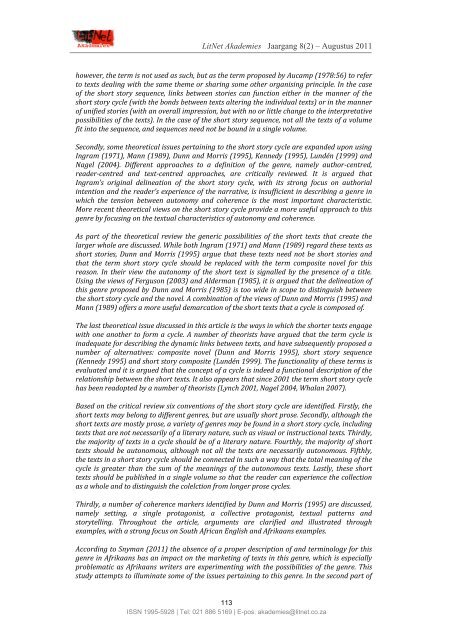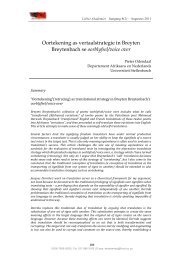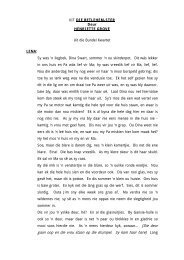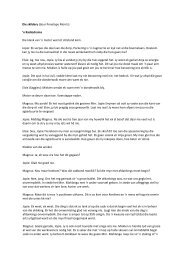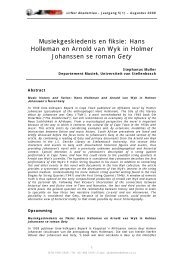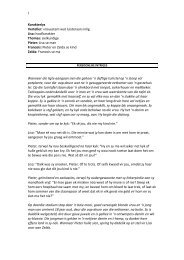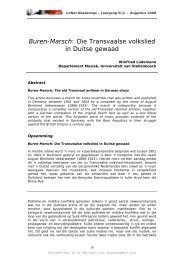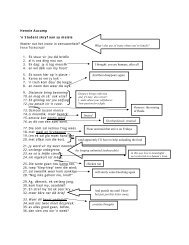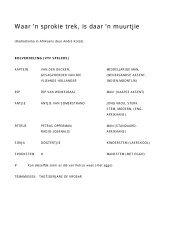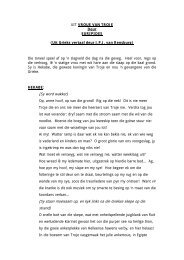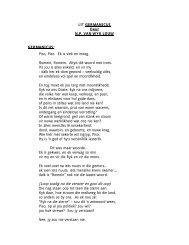Jaargang 8, nommer 2 – Augustus 2011 - LitNet
Jaargang 8, nommer 2 – Augustus 2011 - LitNet
Jaargang 8, nommer 2 – Augustus 2011 - LitNet
You also want an ePaper? Increase the reach of your titles
YUMPU automatically turns print PDFs into web optimized ePapers that Google loves.
<strong>LitNet</strong> Akademies <strong>Jaargang</strong> 8(2) <strong>–</strong> <strong>Augustus</strong> <strong>2011</strong><br />
however, the term is not used as such, but as the term proposed by Aucamp (1978:56) to refer<br />
to texts dealing with the same theme or sharing some other organising principle. In the case<br />
of the short story sequence, links between stories can function either in the manner of the<br />
short story cycle (with the bonds between texts altering the individual texts) or in the manner<br />
of unified stories (with an overall impression, but with no or little change to the interpretative<br />
possibilities of the texts). In the case of the short story sequence, not all the texts of a volume<br />
fit into the sequence, and sequences need not be bound in a single volume.<br />
Secondly, some theoretical issues pertaining to the short story cycle are expanded upon using<br />
Ingram (1971), Mann (1989), Dunn and Morris (1995), Kennedy (1995), Lundén (1999) and<br />
Nagel (2004). Different approaches to a definition of the genre, namely author-centred,<br />
reader-centred and text-centred approaches, are critically reviewed. It is argued that<br />
Ingram’s original delineation of the short story cycle, with its strong focus on authorial<br />
intention and the reader’s experience of the narrative, is insufficient in describing a genre in<br />
which the tension between autonomy and coherence is the most important characteristic.<br />
More recent theoretical views on the short story cycle provide a more useful approach to this<br />
genre by focusing on the textual characteristics of autonomy and coherence.<br />
As part of the theoretical review the generic possibilities of the short texts that create the<br />
larger whole are discussed. While both Ingram (1971) and Mann (1989) regard these texts as<br />
short stories, Dunn and Morris (1995) argue that these texts need not be short stories and<br />
that the term short story cycle should be replaced with the term composite novel for this<br />
reason. In their view the autonomy of the short text is signalled by the presence of a title.<br />
Using the views of Ferguson (2003) and Alderman (1985), it is argued that the delineation of<br />
this genre proposed by Dunn and Morris (1985) is too wide in scope to distinguish between<br />
the short story cycle and the novel. A combination of the views of Dunn and Morris (1995) and<br />
Mann (1989) offers a more useful demarcation of the short texts that a cycle is composed of.<br />
The last theoretical issue discussed in this article is the ways in which the shorter texts engage<br />
with one another to form a cycle. A number of theorists have argued that the term cycle is<br />
inadequate for describing the dynamic links between texts, and have subsequently proposed a<br />
number of alternatives: composite novel (Dunn and Morris 1995), short story sequence<br />
(Kennedy 1995) and short story composite (Lundén 1999). The functionality of these terms is<br />
evaluated and it is argued that the concept of a cycle is indeed a functional description of the<br />
relationship between the short texts. It also appears that since 2001 the term short story cycle<br />
has been readopted by a number of theorists (Lynch 2001, Nagel 2004, Whalan 2007).<br />
Based on the critical review six conventions of the short story cycle are identified. Firstly, the<br />
short texts may belong to different genres, but are usually short prose. Secondly, although the<br />
short texts are mostly prose, a variety of genres may be found in a short story cycle, including<br />
texts that are not necessarily of a literary nature, such as visual or instructional texts. Thirdly,<br />
the majority of texts in a cycle should be of a literary nature. Fourthly, the majority of short<br />
texts should be autonomous, although not all the texts are necessarily autonomous. Fifthly,<br />
the texts in a short story cycle should be connected in such a way that the total meaning of the<br />
cycle is greater than the sum of the meanings of the autonomous texts. Lastly, these short<br />
texts should be published in a single volume so that the reader can experience the collection<br />
as a whole and to distinguish the colelction from longer prose cycles.<br />
Thirdly, a number of coherence markers identified by Dunn and Morris (1995) are discussed,<br />
namely setting, a single protagonist, a collective protagonist, textual patterns and<br />
storytelling. Throughout the article, arguments are clarified and illustrated through<br />
examples, with a strong focus on South African English and Afrikaans examples.<br />
According to Snyman (<strong>2011</strong>) the absence of a proper description of and terminology for this<br />
genre in Afrikaans has an impact on the marketing of texts in this genre, which is especially<br />
problematic as Afrikaans writers are experimenting with the possibilities of the genre. This<br />
study attempts to illuminate some of the issues pertaining to this genre. In the second part of<br />
113<br />
ISSN 1995-5928 | Tel: 021 886 5169 | E-pos: akademies@litnet.co.za


